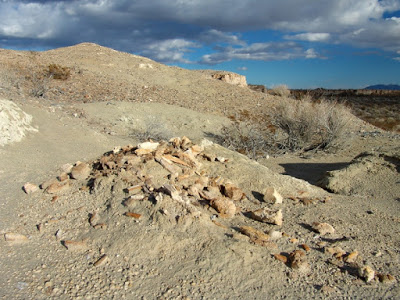According to new U.S. Geological Survey research published today in the Proceedings of the National Academy of Sciences, springs and marshes in the desert outside Las Vegas expanded and contracted dramatically in response to past episodes of abrupt climate change, even disappearing altogether for centuries at a time when conditions became too warm. This new record, gleaned from dirt and rocks exposed in the desert just outside the city limits, provides an unprecedented look into how climate change can affect fragile desert ecosystems in the American Southwest.
Kathleen Springer, a geologist with the USGS and former Senior Curator at the San Bernardino County Museum, was the principal investigator and lead scientist for this study showing that desert wetlands are extremely sensitive to climate change.
“This is a story of water,” said Springer. “Water was plentiful in the desert at times in the past, but when climate warmed, springs and wetlands dried up, and the plants and animals living in the harsh desert environment were out of luck.”
During the Pleistocene, between approximately 100,000 and 10,000 years ago, wetlands dotted the landscape in the area just north of Las Vegas, attracting a plethora of ice age animals, including mammoths, sloths, sabre-toothed cats, dire wolves, and extinct species of bison, horse, and camel, and later, the first human inhabitants to the area.
Today, existing desert wetlands are home to a number of threatened and endangered species that rely on the ecosystem for water in an otherwise arid landscape. Their fate may lie in the hands of a rapidly changing climate.
“What we’re seeing in the geologic record frames what we are observing today,” said Springer. “The drought that California is currently experiencing is extreme, but droughts are an inherent part of the climate system and have occurred repeatedly in the past.”
The study was initiated by the Bureau of Land Management, which called for an integrative approach to studies that emphasize the geological age and context of fossils, as well as a comprehensive analysis of how local hydrologic systems responded to climate change in the past.
“Scientists collect fossils all the time,” said Scott Foss, a senior paleontologist with the BLM. “What is remarkable about this work is the vision that Kathleen had of making sure her team understood the intricacies of the deposits in incredible detail, which allowed them to determine how climate affected the local landscape. It was an immense undertaking, and one that will serve as a benchmark for generations to come for those interested in understanding the effects of climate change on desert ecosystems.”
Studies examining the effects of climate change on springs and desert wetlands will continue through the USGS’s Climate and Land Use Change Research and Development Program, and will build upon the investigations conducted in the Las Vegas Valley, a large portion of which is now protected as Tule Springs Fossil Beds National Monument.
When the monument was established in December 2014, the BLM turned their stewardship over to the National Park Service, who will determine how to interpret the unique land and its former inhabitants for the public.
“The future of this newly designated national monument and what it can tell us about the effects of climate change is all about the past,” said Springer. “And the past is the key to the present.”
Reference:
K. B. Springer et al. Dynamic response of desert wetlands to abrupt climate change, Proceedings of the National Academy of Sciences (2015). DOI: 10.1073/pnas.1513352112
Note: The above post is reprinted from materials provided by United States Geological Survey.











